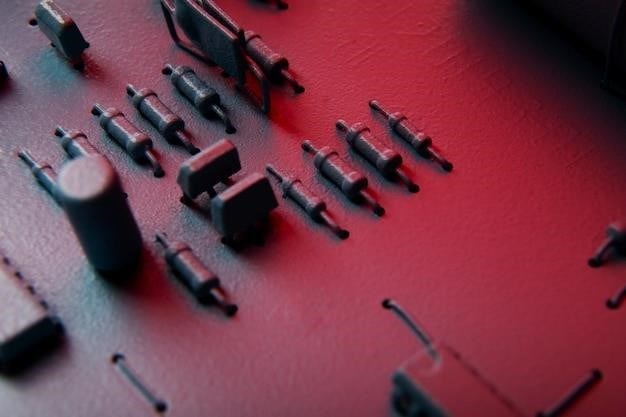Fundamentals of Rock Climbing
Rock climbing demands a blend of skills beyond raw power․ It requires a balance between technique, agility, and mental focus․ Problem-solving is also a key component, along with proper planning․ All these elements are vital for success․
The Balance of Technique, Agility, and Mental Focus
Climbing relies on more than just strength․ Technique, which includes footwork, body positioning, and efficient sequencing, is crucial․ Agility allows for dynamic movements and quick adjustments․ Mental focus helps manage fear, analyze routes, and make strategic decisions․ These three aspects working in harmony are the foundation for consistent climbing success․ This trifecta is essential for any climber to enhance their performance․
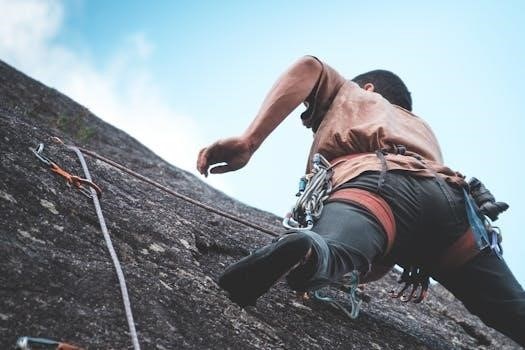
Essential Climbing Techniques
Mastering fundamental techniques is key to climbing efficiency․ This includes effective footwork, precise body positioning, and fluid movement sequences․ These are the core skills that underpin climbing progression and success․
Using Your Feet Effectively⁚ Edging and Foot Placement
Effective footwork is paramount in climbing; think of it as stepping up a ladder, not pulling yourself up․ Edging and precise foot placement are crucial for conserving energy․ Aim to place your feet directly below your body, using small, frequent movements․ Practice making three foot placements for every hand move to refine this skill․ This approach ensures better balance and efficient climbing․
Body Positioning and Sequencing for Efficient Movement
Efficient movement in climbing depends heavily on proper body positioning and sequencing․ Technique involves moving your body and limbs effectively, including footwork and sequencing․ You must position your body in such a way that you can use your legs to push yourself up, not just your arms․ Learn to move slowly, pausing briefly when reaching for holds to improve your control and body awareness․
Training Program Structure
A structured training program should be divided into blocks with specific themes, allowing for subtle changes and variety․ Flexibility is also key, adapting to minor whims, allowing you to enjoy climbing․
Dividing Training into Blocks with Specific Themes
Structuring your training into blocks, each with a dedicated theme, is essential for focused progress․ This approach allows you to concentrate on specific aspects, such as conditioning, endurance, strength, or power․ By allocating themes, you can track development, ensure you address weaknesses, and prevent overtraining․ This method brings a well-rounded approach to climbing development․ This is a key component for efficient training․
Flexibility and Variety in Training Regimen
A robust training plan should be flexible enough to adapt to your current needs, allowing for adjustments based on your progress and the demands of climbing․ Variety is also important to keep things fresh and prevent plateauing․ Incorporating diverse exercises and activities prevents boredom, while also hitting different muscle groups and skills․ A flexible approach keeps you motivated and helps you progress․
Strength Training for Climbers
Resistance training is crucial for climbers․ It helps develop the necessary muscle strength for challenging routes․ Proper exercises improve climbing performance, but using the correct form is essential to avoid injuries․
Importance of Resistance Training
Many climbers should consider adding resistance training to their routines․ It is often misunderstood and misused, so correct practice is key․ It helps to develop power and strength, necessary for difficult moves․ However, it’s important to avoid confusing a hard workout with effective training․ Adding strength to poor technique reinforces poor technique, so focus on correct form first and foremost․ This will enhance overall climbing performance․
Exercises for Crucial Climbing Muscles⁚ Rows and Scapular Retraction
Learning proper row techniques is crucial as it strengthens essential muscles used in climbing․ Scapular retraction improves movement patterns, and enhances success with other exercises․ These exercises build a solid base for pulling movements, a cornerstone of climbing․ It’s important to focus on correct form to maximize benefits and avoid injury․ By properly engaging these muscles, climbers can improve power and efficiency on the wall․
Endurance Training for Rock Climbing
Endurance training is critical for climbers; Supplement climbing with cardio activities to boost stamina․ Toprope laps build rock endurance․ These methods help maintain the necessary energy levels for longer climbs․
Cardio Activities to Supplement Climbing Time
In addition to climbing, incorporate cardio exercises two to three times a week for about 30 minutes․ This will improve your cardiovascular fitness, which is crucial for sustained climbing performance․ A strong heart helps pump blood efficiently to working muscles․ Suitable options include running, cycling, or swimming, supporting overall endurance and stamina required for longer routes․
Toprope Laps for Developing Endurance on Rock
Toprope laps are an effective method for building climbing endurance․ This involves repeatedly climbing routes without rest, focusing on maintaining consistent movement․ This approach helps in developing the specific muscular endurance needed for longer climbs․ It is beneficial to choose routes that are challenging but manageable to ensure you are working your endurance rather than your maximum strength․
Technique Refinement
Identifying and correcting bad habits is crucial for progress․ Focus on learning new techniques and ways to complete moves to climb smoothly․ This helps create effective patterns and improve overall climbing․
Identifying and Correcting Bad Habits
Recognizing ingrained bad habits is crucial, as these can hinder progress․ Learning and practicing effective techniques helps build positive movement patterns, allowing you to climb more smoothly․ The goal is to identify weaknesses and find new techniques to perfect to fix bad habits․ This process will improve your climbing efficiency and skill over time․
Focus on Small, Frequent Foot Placements
On real rock, techniques like high-stepping or wide stances are often less effective․ Instead, practice making small, frequent foot placements․ Aim for three foot placements for every hand move, adding intermediate steps when necessary․ This approach enhances precision and control․ This also improves balance and makes climbing more efficient and less strenuous․
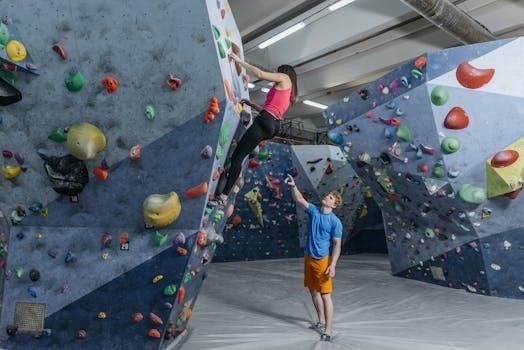
Mental Preparation
Climbing involves managing fear and honing mental skills․ It’s essential to analyze routes and boulders mentally before attempting them․ This preparation improves performance and builds confidence on the rock․
Managing Fear and Developing Mental Skills
Overcoming fear is crucial in climbing; it involves building confidence through practice and controlled exposure․ Developing mental skills, like focus and visualization, can enhance performance․ Analyzing routes mentally before climbing will improve decision-making and reduce hesitation․ Practicing mindfulness techniques can also help climbers stay present and manage anxiety, thus enabling them to push their limits safely and effectively․
Analyzing Routes and Boulders Mentally
Before starting a climb, visualize the moves․ Identify potential challenges and plan sequences, which enhances confidence․ Mental rehearsal allows for anticipation of holds and body positions, improving fluidity and reducing hesitation․ Spend time observing the route, noting key features, and creating a strategy․ This preparation transforms complex challenges into manageable steps, which is very useful for climbing and improving skill․
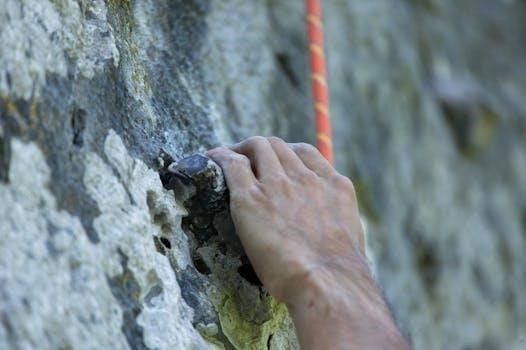
Beginner Training Program
Beginners should focus on learning climbing skills and refining technique․ General conditioning is also crucial, as is developing mental skills to manage fear․ It’s also important to build stabilizer and antagonist-muscle strength․
Focusing on Skills, Technique, and General Conditioning
New climbers should prioritize learning fundamental skills and proper technique early on․ This includes efficient footwork, body positioning, and movement sequencing․ Alongside skill development, a general conditioning program is crucial․ This will build a base level of fitness, improving overall strength, endurance, and flexibility․ Focusing on these aspects will set a solid foundation for future climbing progression and prevent injuries․
Importance of Stabilizer and Antagonist-Muscle Strength
Climbing heavily relies on stabilizer muscles for balance and control, making their strength crucial․ Antagonist muscles, which oppose the primary movers, are also important for preventing injuries and promoting well-rounded strength․ Neglecting these muscle groups can lead to imbalances, hindering performance and increasing the risk of strains or sprains․ Training these muscles improves stability, movement efficiency and overall climbing ability․
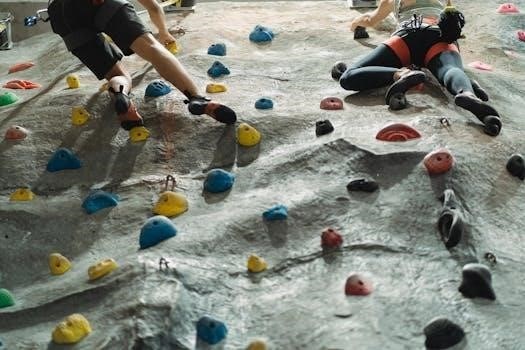
Specific Climbing Techniques
Advanced techniques like kneebars, drop-knees, and flags can enhance efficiency․ Heel-toe cams and smearing provide additional options for challenging moves․ Mastering these skills expands a climber’s repertoire of tools․
Kneebars, Drop-knees, and Flags
Kneebars are a mega technique, using the knee to create a locking position, providing rest․ Drop-knees involve rotating the knee inward for reach or balance․ Flags extend a leg for counter-balance․ These advanced moves conserve energy․ Each technique optimizes body position, enhancing efficient movement on the rock, and are essential to master for challenging climbs․
Heel-Toe Cam and Smearing Techniques
Heel-toe cams use the heel to create a secure hold by pressing and rotating․ Smearing uses friction by placing the foot on a wall with no specific hold․ These techniques are efficient for different situations; Smearing relies on the right body tension and angle, while heel-toe cams enhance stability and leverage, requiring precision and understanding of foot placement․
Home Workout Exercises
Maintain climbing shape with home exercises when you can’t access a wall․ Focus on core strength using planks and leg raises․ This will improve your balance and climbing performance․
Maintaining Climbing Shape Off the Wall
When you can’t get to the climbing gym, you should maintain your fitness with home workouts․ These are key to staying in climbing shape․ Focus on exercises that mimic climbing movements to ensure your muscles are ready for your next climb․ This can be achieved through bodyweight training, focusing on your core and antagonist muscles․ Consistency is more important than intensity․
Core Strengthening Exercises for Balance
A strong core is essential for maintaining balance while climbing․ Incorporate exercises like planks, side planks, and leg raises into your routine․ These exercises will help stabilize your body during complex movements on the wall․ Focus on engaging your core throughout each repetition․ Remember, a stable core translates to better control, balance, and overall climbing efficiency․ Consistency is key for core strength․




